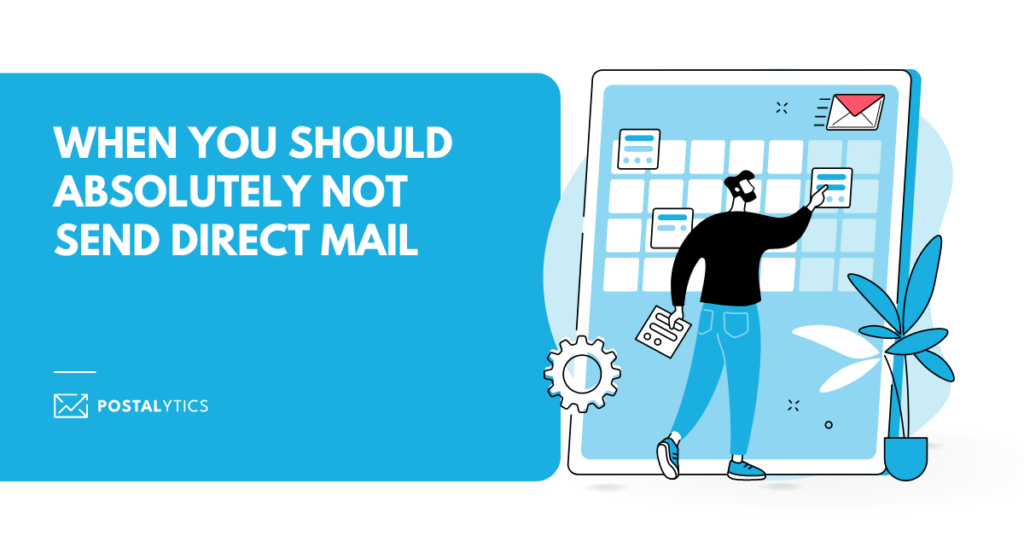
A direct mail campaign that falls flat isn’t just a blow to the ego, but a hit to your marketing budget, too. A campaign can yield unsatisfactory results for lots of reasons, such as an untargeted list or an unconvincing offer. But the problem might also be related to when you’re sending the mail.
Timing is vital in direct mail campaigns. Mail that arrives at the right time can produce amazing results, but poorly timed mail can be a dud. Would you pay attention to a sales pitch in the middle of a crisis or when you’re swamped with work? Probably not! Your customers feel the same. Your goal as a marketer isn’t only to send the right offer but to send it when your audience is most likely to engage with it.
Be aware of how seasonal swings, industry events, or holidays affect your target audience. Schedule your direct mail campaigns to coincide with the ideal times for them. Avoid periods when your customers are less likely to pay attention to your message.
It is said that the right message to the wrong people is the wrong message. We’d add that the right message at the wrong time is also the wrong message.
What We’ll Cover:
Know Your Audience: When to Hold Off on Mailing
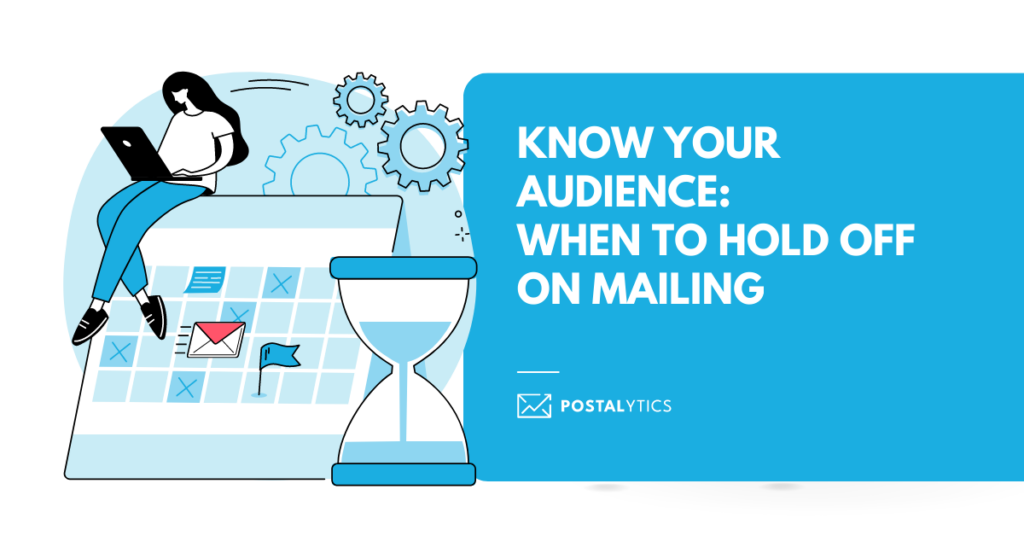
Consider the work cycle of your target audience. If you’re trying to reach educators, for example, sending mail early in the summer break might not be the best idea. They’re likely out of school and not focused on work-related matters.
Here are a few more specific examples where timing can make or break your direct mail campaign:
Businesspeople during peak times: Mailings to business professionals during their busiest periods, such as end-of-quarter or annual budgeting, may not garner the attention they deserve.
Florists before major holidays: Valentine’s Day and Mother’s Day are incredibly busy times for florists. They’re swamped with orders and unlikely to give marketing pieces a second glance.
Tax preparers in April: April is crunch time for tax professionals. They hardly have time for sleeping, much less scrutinizing marketing mail. Many of them take well-earned vacations after April 15th, so don’t be too quick to resume your campaigns aimed at the tax preparation industry. Wait until May or June.
Consumers during pre-election: Before an election, political literature floods mailboxes. Your marketing material may be lost in the noise.
Decision-makers during strategic planning: If you’re targeting C-suite executives, avoid sending mail during key strategic planning or budgeting periods. Their focus will probably be elsewhere.
It’s absolutely crucial to understand your target audience and align your direct mail campaign accordingly. Any group can experience predictable periods of high and low activity. Strategic timing can make the difference between customers acting upon your message and ignoring the mail completely.
Sometimes, approaching prospects directly following their busy time can be effective. Direct mail pieces can highlight common headaches the audience has recently encountered while the experience is still fresh in their minds. Your offer that suggests a solution may be welcomed by customers who don’t want to repeat the pain of their recent overwhelming experience.
The Pitfalls of Poor Timing
There’s a subtle art to direct mail marketing, one that requires more than simply an enticing offer and a well-curated list. Timing, as they say, is everything. And in the realm of direct marketing, poor timing can be a hazard that significantly diminishes the success of your campaign.
When your ideal prospects are super busy, they devote their time to the highest priority tasks. Reading and responding to an offer that arrives in the mail isn’t one of them. Unfortunately, some businesses focused on their own priorities (like hitting their quarterly sales targets) forget about this fact. They plan and execute their marketing campaigns as if the calendar had no impact on their customers-and waste money doing it.
A poorly timed direct mail campaign can be a disaster. Response rates and conversions will not meet expectations, and you will have squandered a portion of the annual marketing budget. Even worse, a campaign executed at the wrong time might convince company executives that direct mail is not a viable marketing channel for your company, causing them to withhold funding for future efforts.
Without a direct mail component, organizations are driven to low-performing alternatives like email or other digital channels. Direct mail done well returns impressive results. See our article “47 Direct Mail Statistics Marketers Should Know in 2023“.
The lower response rate of a direct mail campaign sent at the wrong time may also influence decisions about the content of future efforts. Because the sample size may be depressed, the response measurement could be flawed. Organizations might change a perfectly good offer or design based on their analysis of campaigns where low audience participation skewed the results. That could be a mistake.
Can Direct Mail Still be Effective in Busy Times?
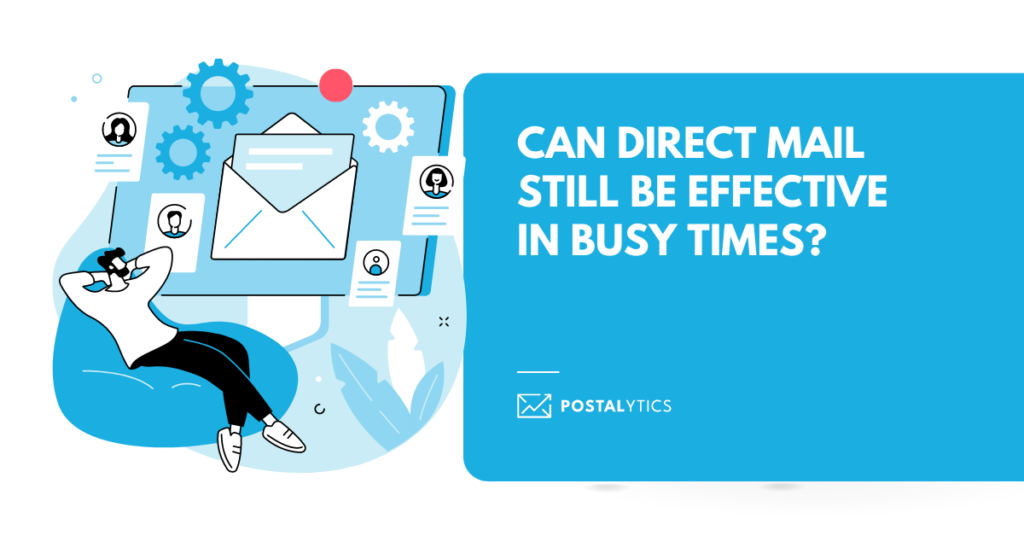
Good question. And the simple answer is–it depends. It’s fair to say that when your customers are at their busiest, the impact of your direct mail campaign may be diluted. Their attention is elsewhere and that beautiful marketing piece you’ve spent time and resources on might end up lost in the shuffle.
However, that’s not to say it’s a complete no-go. It really depends on your target audience, their schedule, their profession, and their tendencies.
Here are some things to remember when you must mail during your customers’ busy times:
Finding an opening. Even habitually busy organizations have seasons, months, or even days of the week when things slow down a bit. Identifying these quiet periods and launching your campaign during these times can increase your chances of catching your target audience’s attention.
Content that stands out. If you send mail during a busy period, make sure it’s something that stands out. Design material that immediately grabs the reader’s attention and compels them to pay attention, even if they’re swamped with other tasks.
Make it easy. Be sure the call to action (CTA) appearing on direct mail that arrives when prospects are especially busy is something quick and easy for them to do. Urging them to set aside 30 minutes for a discovery call may not be the best strategy. Try replacing your normal CTA with a fulfillment offer that provides prospects with something they perceive as valuable. Allow customers to request the item with simple action, like scanning a QR code or sending a short code via a text message.
Direct Mail Alternatives During Busy Times
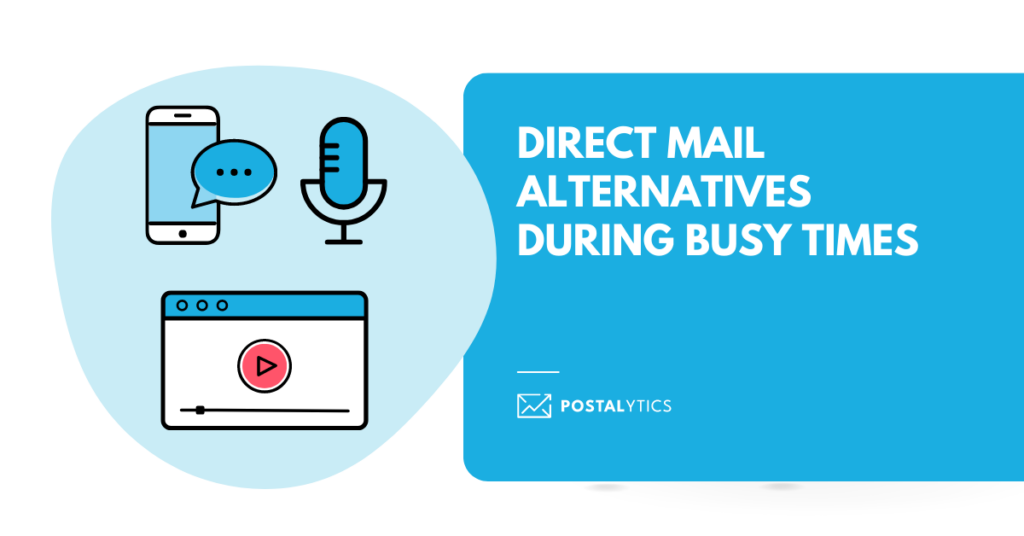
You don’t have to go into hibernation when direct mail isn’t the best choice. Alternative marketing strategies can be effective, even during your customers’ busiest times, though you should still be conscious of their time constraints. Whatever method or marketing channels you choose, make sure your messages are brief and call for an easily executed action on the part of the recipients.
Remember that a customer’s action initiated in another medium can prompt follow-up or fulfillment via direct mail. You shouldn’t be discouraged from using mail to communicate with prospects who responded to your offer, regardless of when that action occurred.
Here are a few alternatives to consider in periods when spending money on direct mail is ill advised:
- Text message marketing: With this approach, you can ping your customers directly, right in their pockets. Being digital, text messages won’t contribute to the physical clutter during peak periods. You can time and tailor texts to suit your customers’ schedules.
- Video sharing platforms: Sites like YouTube, TikTok, and Vimeo offer a space for you to engage with your customers. Share news, deals, or even start live interactions. If you upload appropriate content for the moment, your audience will find time to watch. The videos should be short, but they can still deliver plenty of information compared to a written letter or postcard.
- Podcasting: Through an episodic series of spoken-word content, podcasts can be a source of valuable knowledge for your customers. This marketing tactic sets you up as a thought leader and strengthens connections. Podcasts are easy to consume while on a break or during the commute to and from work. If you’ve paused direct mail during the customers’ busy season, try promoting podcasts that deliver timely executable advice that can be useful even if your prospects are temporarily swamped.
Triggered Direct Mail
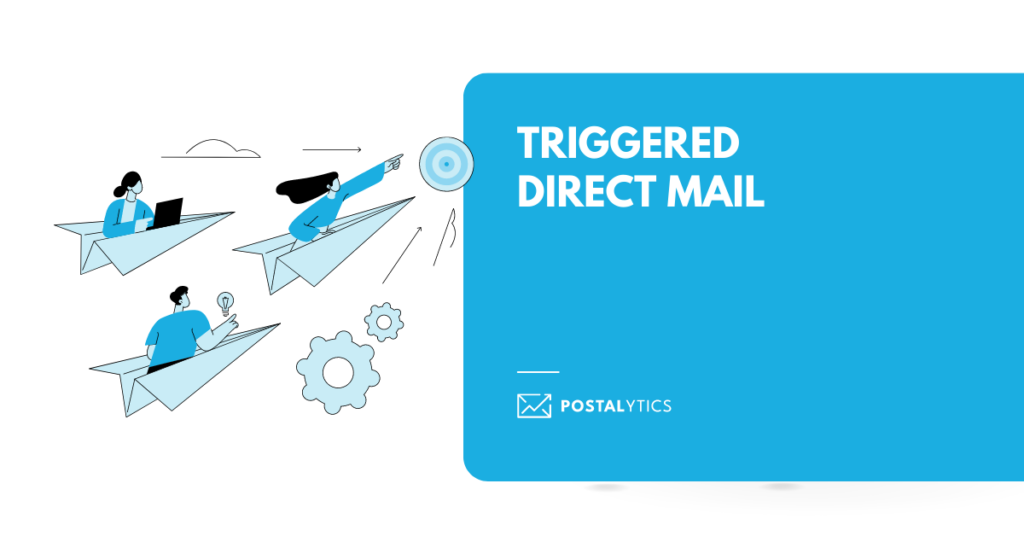
So far, we’ve been discussing the timing for batch campaigns, where you send mail (which can contain variable content) to a list of customers or prospects. The individuals on your batch mailing list might share common demographic characteristics, but they did nothing specific to be included. At Postalytics, we call these batch operations Smart Send campaigns. Triggered direct mail, however, is much different. If a customer or prospect in your CRM has taken action or exhibited a behavior you’ve defined as a trigger, you should absolutely send them mail–regardless of when that trigger was activated. In fact, it’s best to respond as soon as possible.
Triggered direct mail is an innovative strategy designed to put your marketing message in the hands of selected target audience members when they’re most likely to be receptive.
By focusing on the status, actions, or behavior of individual customers, triggered direct mail can significantly increase your chances of engagement. It’s all about timing and understanding your customer’s journey. Three factors determine the success of triggered direct mail.
1. Understanding Your Customer
The first step in any successful triggered direct mail campaign is understanding your customer. You need to recognize their preferences and pain points. This data isn’t only about demographics; it’s about behavior. What actions are your customers taking that could trigger a direct mail piece?
Some customer information marketers find useful for triggers:
- Purchase information (product, purchase date, warranty)
- Personal information (gender, birthdate, address, email address)
- Customer loyalty data (bronze, silver, or gold customer, first purchase date, loyalty points)
- Online activity (website visit data, social media, content downloads)
2. Creating the Right Triggers
Triggers could be anything from a recent purchase to browsing behavior on your website. The key is to make sure these triggers are relevant and opportune. For example, a retail store might send a direct mail piece to a customer who has made a big purchase, offering complementary products or a future discount. Triggers can even be based on something a customer doesn’t do. A customer who stops opening your email messages, for instance, might be targeted for contact via the mail.
Some trigger examples:
- Customer reaches a certain age
- Customer’s warranty or insurance policy is about to expire
- Customer achieves a certain level of loyalty points
- Customer abandons an online shopping cart
- Customer’s birthday
- Customer reaches milestone purchase anniversaries
- Customer moves to a new home
3. Responding at the Right Time
You want your direct mail piece to hit just when your customer is most likely to be thinking about your product or service. That means not only identifying the right triggers and, using automation, ensuring your direct mail piece arrives at the right time.
A well-timed offer increases the relevance of your message to the recipient. If you offer something that interests the recipient at the time they receive your mail, they are more likely to read your message and act. These offers can also create a sense of urgency. If you offer a limited-time deal or discount, the recipient is more likely to act quickly before the offer expires. This can lead to higher response rates and sales.
Postalytics is the platform that automates direct mail. We make Smart Send campaigns as easy to set up and execute as an email blast, and we also integrate with your CRM, enabling you to create triggered communications based on the criteria that matter to you.
By implementing these smart strategies for triggered direct mail, you’ll increase your chances of getting your marketing message in front of your target audience when they’re most receptive. It’s a winning strategy for both your audience and your bottom line.
The art of direct mail demands strategy and timing. By understanding your audience, leveraging triggered mail, and avoiding mailing black holes, you can ensure your investment in direct mail delivers the results you expect.
About the Author

Dennis Kelly
Dennis Kelly is CEO and co-founder of Postalytics. Dennis joined Boingnet, the predecessor to Postalytics, in 2013. Boingnet was focused on providing print and direct mail marketing service providers the ability to add digital marketing channels to their direct mail campaigns. Postalytics is Dennis’ 6th startup. He has been involved in starting and growing early-stage technology ventures for over 30 years and has held senior management roles at a diverse set of large technology firms including Computer Associates, Palm Inc. and Achieve Healthcare Information Systems.
